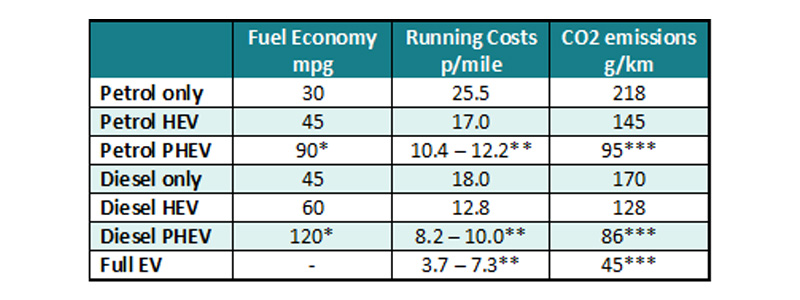By Professor Roy Douglas, CTO and Co-Founder CATAGEN
Hybrid cars (HEVs) are becoming a popular alternative to conventional petrol and diesel cars as many of us still struggle to take the big step towards full battery electric cars (BEVs). HEVs offer better fuel economy and hence lower running costs while making us feel that we are doing our bit to save the planet by reducing our emissions footprint. The key contribution is better fuel consumption and hence lower carbon emissions.
But the big question is how much?
Let’s take a typical family car as an example. This car, with a diesel engine, will return about 45mpg (6.2 l/100km) on average and about 40mpg for inner city driving, and the petrol version about 30mpg (9.4 l/100km) with 24mpg inner city. In a similar hybrid (HEV), there are 4 main feature that contribute to savings in fuel consumption:
- Start/stop technology allows the engine to be stopped when the car is stationary and improves fuel economy by about 3mpg (10%).
- Electric only mode can be used during low speed driving where engines are inefficient and can give a further improvement of around 5mpg (17%).
- Regenerative braking, where braking force is provided by the electric motors, captures the kinetic energy of the car as electrical energy and will deliver a further 7mpg (21%).
- Plug-in hybrids (PHEVs) offer the further advantage of charging the vehicle from the grid and operating for a large proportion of driving in full EV mode, giving similar benefits to a full BEV with lower running costs and reduced CO2
Adding these factors together gives an overall improvement of about 15mpg (50% for the petrol car) on average for fuel economy for a self-charging hybrid (HEV) and similar improvements in CO2 emissions. So, as shown in table 1, our family car as a hybrid will have 60mpg (4.7 l/100km, 127 g/km CO2) as a diesel HEV and over 45mpg (6.2 l/100km, 145 g/km CO2) as a petrol HEV. This benefit will depend on driving conditions so someone motorway driving will see a lesser benefit and in-town driving will be better. Further benefits can be achieved with a plug-in hybrid (PHEV) where part of the driving is in EV mode (or electric only). If a PHEV is run in EV mode for 50% of driving then the apparent fuel economy will double as this does not take the electrical power into account. For CO2 emissions, the equivalent petrol PHEV would emit 95 g/km CO2 and the diesel PHEV about 85 g/km CO2.

Table 1: Fuel Economy, Running Costs and CO2 Emissions
* does not include electrical energy
** depending on price of electricity
*** at current carbon intensity of grid power
Where we will all notice the benefits of hybrid vehicles most is in our pocket with reduced running costs, particularly with the current high fuel prices.
At current UK fuel prices in 2022, as shown above, the diesel car example would see costs reducing from 18p/mile to 13.5p/mile (25%) and the petrol car from 25.5p to 17p (35%)
Interestingly, the benefits for the petrol car are greater reducing the gap to diesel. Similar percentage benefits are seen over a wide range of cars with larger benefits for larger cars. The plug-in hybrid (PHEV) can reduce these running costs even further. On electrical power, this cost will be between 4p and 7p/mile depending on whether you are using daytime charging or lower cost overnight charging. So with a typical PHEV giving about 25 to 50 miles EV range, this can generate savings of around 10p/mile relative to non-hybrid cars equating to a monthly saving of £80 to £100 on fuel and, as indicated above, large reductions of CO2 emissions of around 50%
In summary, self-charging hybrids offer fuel economy benefits of around 25% with the associated saving in cost and CO2 emissions. Plug-in hybrids (PHEV) offer further cost savings of around 25% due to lower cost of electrical power from the grid. PHEVs also give enhanced saving in CO2 emissions of around 50% relative to non-hybrid cars, which can have a significant impact on the road to Net Zero Emissions.
Bio – Professor Roy Douglas
Roy is Chief Technical Officer, a Director and one of the founders of Catagen Ltd. He is Professor Emeritus of IC Engines Technology in the School of Mechanical and Aerospace Engineering at Queen’s University, Belfast. He has over 40 years of experience in the areas of engine research and development, systems modelling and automotive after-treatment. For the past 25 years, his

research has concentrated on improving the performance of automotive after-treatment systems, with particular emphasis on applied catalysis at the interface between chemistry and engineering. He is keenly interested in improved air quality through application of ultra-low emissions technology on the roadmap to zero tailpipe emissions for the automotive industry.
He has published over 100 technical papers with 4 granted patents: he has supervised over 40 PhD research students and over 20 Post-doctoral research fellows; he has research earnings of over £25 million.
He was a senior member of the School of Mechanical & Aerospace Engineering and a member of the school management team. He is currently a member of the Automotive Council Technical Committee in the UK and a member of the International Advisory Board for the Virtual Vehicle Research Centre at TU Graz, Austria.
More Content:











